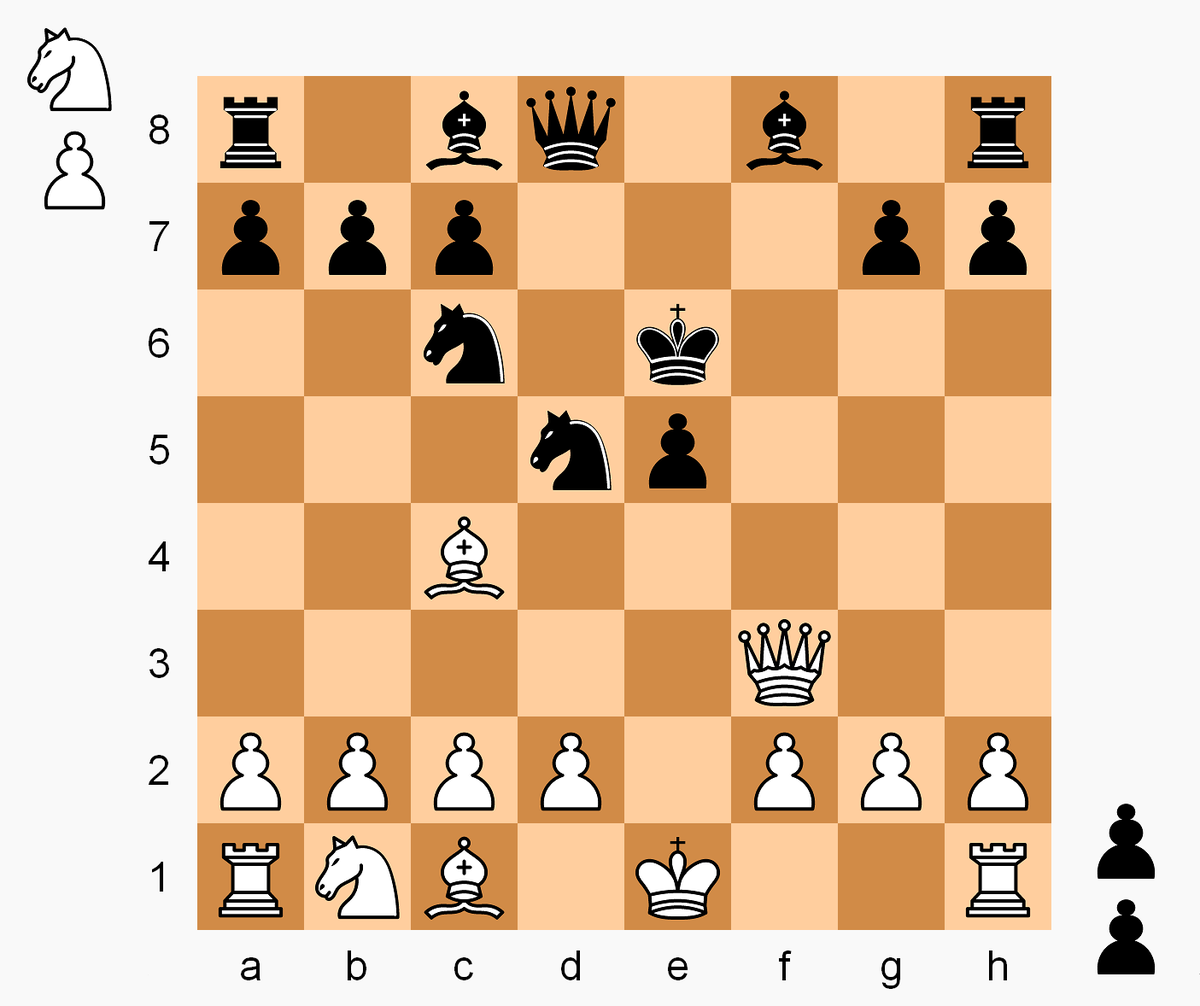 | ||
Hostage Chess is a chess variant invented by John Leslie in 1997. Captured pieces are not eliminated from the game but can reenter active play through drops, similar to shogi. Unlike shogi, the piece a player may drop is one of his own pieces previously captured by the opponent. In exchange, the player returns a previously captured enemy piece which the opponent may drop on a future turn. This is the characteristic feature of the game.
Contents
- Game rules
- Hostage exchanges
- Drops
- Pawn promotions
- Advantages over Chessgi
- Notation
- Example game
- References
Hostage Chess has tactical subtlety and "tends to favour the attacker". In 1999, David Pritchard called the game "the variant of the decade". It was published in magazines Nost-algia (issue 375), Eteroscacco (86–88), and Variant Chess (32 and later). It was the "Recognized Variant of the Month" in January 2005 at The Chess Variant Pages.
The inventor, John Leslie, is also a philosopher. He mentions in his book Infinite Minds that the prevalence of chess variant inventions such as Hostage Chess has led to speculation that there could be infinite possible variations of chess. He contends these will necessarily exceed the capacity of the human mind.
Game rules
Hostage Chess follows all the standard rules of chess excepting how captured men are treated. Each player owns reserved spaces off the chessboard: a prison to the player's right, and an airfield to the player's left. Captured men are not removed from the game but are held in the capturer's prison. Instead of making a normal move, a player can execute a hostage exchange to "rescue" a man held prisoner by the opponent and drop the freed man back into play on the board on an open square. The man exchanged for the dropped man is transferred from the player's prison to the opponent's airfield. On any turn, instead of making a normal move, a player can drop a man from his airfield into active play on the board.
Hostage exchanges
A hostage exchange is executed by transferring a man from one's prison to the opponent's airfield, then selecting and releasing a man from the opponent's prison and immediately dropping it on an empty square on the board. The drop completes the turn. The man transferred must be of equal or greater value than the man released from prison and dropped. The relative piece values are: Q > R > B = N > P. (So, any man can be exchanged to free a pawn; whereas only a queen can be exchanged to free a queen.) A hostage exchange cannot be refused by the opponent.
Drops
A drop can occur as part of a hostage exchange, or directly from a player's airfield. The square dropped to must be unoccupied. Additional drop rules:
Pawn promotions
A pawn can promote only to an available Q, R, B, or N in the opponent's prison. The promoting player selects which piece to release and promote to; the pawn is transferred to the opponent's prison. If the promoted piece is subsequently captured, it retains its type when entering prison.
So, in the case of a pawn on a player's 7th rank with no available piece to promote to, the pawn cannot advance. Additionally, if the opponent's king is diagonally in front of the pawn:
Advantages over Chessgi
According to David Pritchard:
Hostage Chess, for want of a better description, is a Chessgi variant. But a variant with two advantages. In the first place, it uses a single chess set, effectively pushing Chessgi, with its requirement for two sets and the almost inevitable confusion that that causes (have you tried playing it over the board?) into limbo, except perhaps for correspondence play. And secondly it introduces additional skill elements that are difficult to evaluate, which in my view make the game much more interesting.
Notation
Standard notation is used with some extensions. A drop is indicated by symbol *. For a hostage exchange, parentheses contain the man exchanged followed by the man freed from prison and dropped. For example, (B-N)*c7 means a bishop was exchanged to free a knight, and the knight was dropped on c7. Pawns are notated P in hostage exchanges, for example: (P-P)*g5. The move N*c7 means a knight was dropped on c7 from the player's airfield. The move *g5 means a pawn was dropped on g5 from the player's airfield.
Example game
Frank Parr vs. David Pritchard, casual game:
1. d4 d5 2. c4 dxc4
3. Nc3 e5 4. d5 c6 5. e4 b5 6. dxc6
Now White also holds a hostage.6... (P-P)*d4
Black exchanges hostages and drops his freed pawn on d4. White now has a pawn in his airfield.7. *d7
White drops the pawn from his airfield. Black is not in check since White cannot promote, there being no imprisoned piece with which the pawn could be exchanged.7... Nxc6 8. Qxd4 Bxd7
The queen could not be taken without an illegal self-check, because of the pawn waiting to promote. But now the queen is threatened.9. Qd1 (P-P)*d4 10. Nd5 Bb4+ 11. Bd2 Bxd2+ 12. Qxd2 Be6 13. a4
13.*b7!? with the idea (B-B)B*c7 (Pritchard).13... Bxd5 14. exd5 (B-B)B*b4 15. *c3 dxc3 16. bxc3 Bxc3! 17. Qxc3 (N-B)B*b4 18. Qxb4 Nxb4
To free his queen from prison, White must first capture Black's queen. But Black can sacrifice his queen anytime, then promptly re-enter it via a hostage exchange.19. Rb1 (P-P)*d2+ (see diagram) 20. Kxd2
Pritchard annotates:20... Qxd5+ 21. Kc1 Na2+ 22. Kc2 (P-P)*b3+ 23. Kb2 (Q-B)B*c3+ 24. Ka3 b4#
